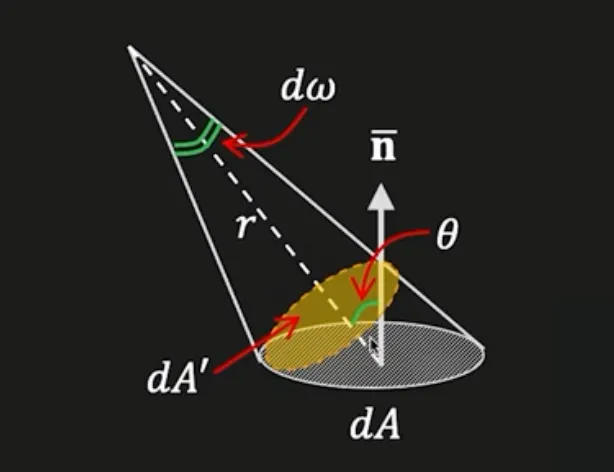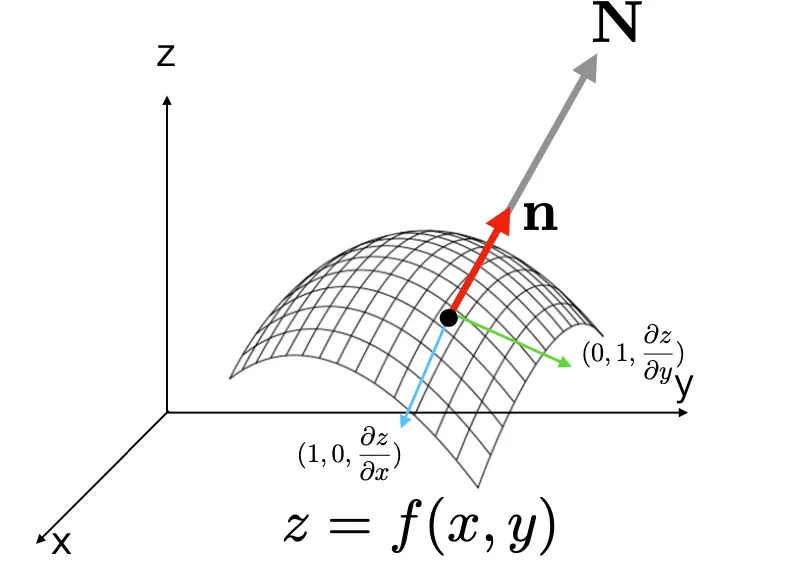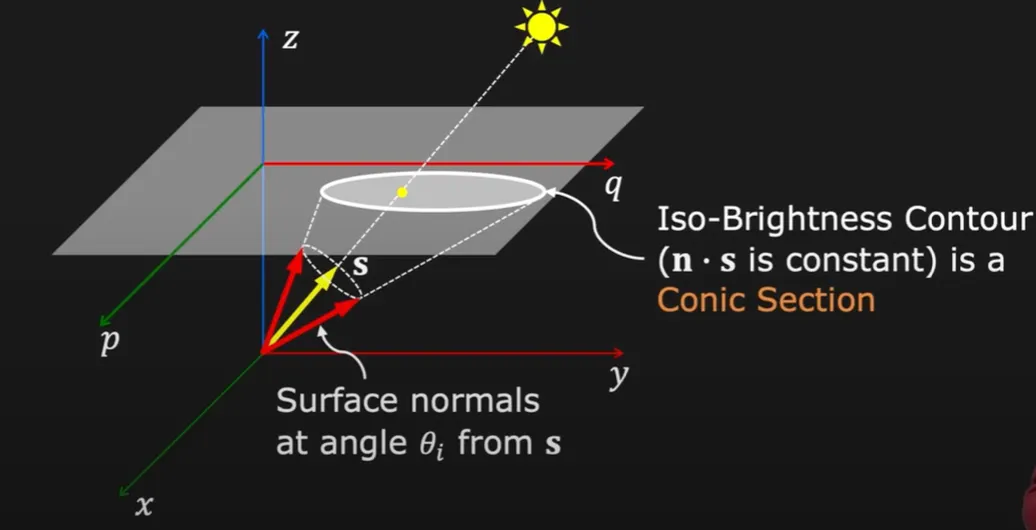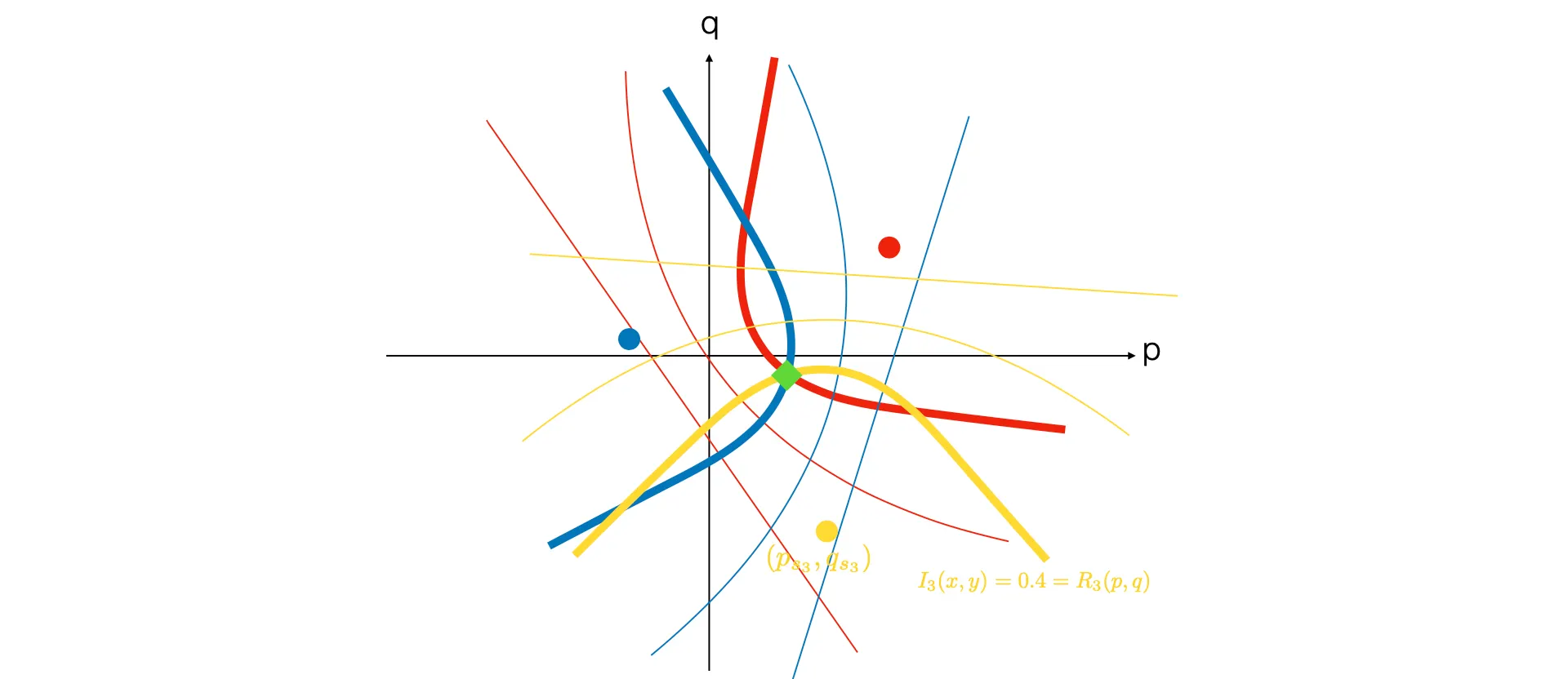Understanding Image Intensity
•
3D information 과 Intensity, Lighting, Normal 의 관계가 무엇일까?
◦
Shape from Shading
▪
Input: An Image
▪
Output: Suface Normals
◦
Photometric Stereo
▪
Input: Multiple Images with different Light Conditions
▪
Output: Surface Normals → 이미지와 그 픽셀 색상으로 normal 을 표현할 수 있음.
How Image Intensity is Determined
•
Image Intensity (pixel value) 로부터 Surface Orientation (Normal Direction) 이 목표임.
•
Surface Orientation 을 얻으면 3D Shape 을 계산할 수 있음.
3D Polar Angle
•
Zenith: 법선으로부터 Ray 와의 각도
•
Azimuth: 평면 위의 고정된 north 에서부터 ray 의 projection 위치까지의 각도
Concept: Angle (2D) & Solid Angle (3D)
•
Angle
◦
Radian 각은 반지름과 호의 비율로 정의할 수 있음.
◦
원은 radian 을 가짐.
•
Solid Angle
◦
Steradian 각은 평면과의 거리와 사영된 면적으로 정의할 수 있음.
◦
High , High Solid Angle
◦
Low , High Solid Angle
◦
Low , High Solid Angle
◦
Sphere 는 steradian 을 가짐.
Concept: Light Flux & Surface Irradiance / Radiance
•
Light Flux ()
◦
Solid Angle 을 통해 방출되는 Power (단위: )
•
Surface Irradiance ()
◦
단위 면적 당 받는 Light Flux (단위: )
◦
가 단위 Solid Angle 당 Flux 이면, Light Flux
◦
High , High
◦
Low , High
◦
Low , High
•
Surface Radiance ()
◦
단위 면적, 단위 Solid Angle 당 방출되는 Light Flux (단위: )
◦
High , High
◦
Low , High
◦
Low , High
◦
Low , High
BRDF: Bidirectional Reflectance Distribution Function
•
BRDF 는 Surface Radiance 와 Surface Irradiance 의 비율
◦
Viewing, Illumination Angle 모두에 의존한 값임.
◦
: Zenith, : Azimuth
•
단위는 다
•
Surface 에 따라서 다음과 같은 다양한 형태의 BRDF 가 존재함.
◦
Surface Normal 을 얻기 위해서는 2D pixel value 와 관련이 있는 Illumination 을 이용하는데, 이 값은 BRDF 에 영향을 받는 값이고, 이 BRDF 를 결정짓는 물체의 property 를 아는 것이 중요함.
◦
보통은 Lambertian (Diffuse) 을 가정하고 문제를 해결하는 경우가 많음.
Diffuse & Specular Reflections
•
Diffuse Reflection: 모든 방향으로 동일하게 Light 를 분산시킴.
•
Specular Reflection: 특정 방향으로만 Light 를 반사시킴.
•
Combined: Diffuse Reflection 과 Specular Reflection 이 적당히 섞임.
Lambertian Reflectance Model for Body Reflection
•
Viewpoint 에 관계없이 같은 부분이면 같은 Illumination 으로 보이는 BRDF.
•
강한 assumption 이지만 동시에 대중적인 assumption 임.
•
는 Albedo 로, 빛의 반사율이라고 볼 수 있음.
◦
검은색일수록 낮고, 흰색일수록 높음.
•
는 각각이 unit vector 라는 가정 하에 를 나타냄.
•
의 방향과 Illumination , Light Power, Distance from the light, Albedo 등을 알면 Surface Normal 을 구할 수 있음.
Diffuse Reflection and Lambertian BRDF
•
동일한 광원과 동일한 거리를 가정하면, 오직 광원의 각도가 특정 부분에서 이미지의 픽셀값을 결정함.
Example of Lambertian Model
•
가장 밝은 지점 는 광원의 방향과 동일한 곳임. ()
•
근처로 동일한 거리의 원형 contour 는 밝기가 같음.
◦
값이 모두 동일한 점들이기 때문임.
◦
이러한 contour 를 Iso-Brightness Contour 라고 함.
◦
이 점들은 Brightness 가 같은데 Surface Normal 이 다르기 때문에 2D Image Pixel 정보만으로 Surface Normal 을 구하는데 ambiguity 를 부여하는 요소임.
Reflectance Map
•
3D Shape 을 다음과 같이 로 나타낼 수 있음.
•
방향의 gradient 와 방향의 gradient 는 다음과 같음.
•
Surface Normal Vector 는 다음과 같이 방향의 tangential vector 와 방향의 tangential vector 의 cross product 를 통해 구할 수 있음.
•
Unit Surface Normal Vector 는 normalize 를 통해 다음과 같음.
PQ Plane Representation
•
Surface Normal 은 만으로 표현이 가능하고, 위의 평면 위의 점 하나로 Surface Normal 을 표현할 수 있음. 해당 평면 위의 점의 좌표를 로, 좌표를 로 취급하면 됨.
•
이는 Light Source Direction Vector 에서도 동일하게 적용되어 다음과 같이 표현할 수 있음.
Iso-Brightness Contours
•
위 식에서 가정을 도입하면 다음과 같은 식이 완성됨.
•
앞선 PQ Plane Representation 의 식을 도입하면 이는,
◦
결국 가 동일할 때의 의 집합이 Iso-Brightness Contour 가 되고, 가 이들의 집합을 나타내는 식이 됨.
◦
이 Contour 는 conic 형태임.
•
우리가 해야하는 것은 특정 Brightness 를 가지는 다양한 들 중 어떤 친구를 선택해야 정확한 Surface Normal 을 선택할 수 있는지 알아야 함.
Photometric Stereo
•
Known Point Light Source 를 세 개 이상 준비하여 각각에 따라 동일한 viewpoint 에서의 이미지를 이용해 3D Shape 을 얻어내는 방법
•
Corresponding Points 들에 대한 Brightness 를 각 이미지에서 구하고 (이 때, Corresponding Point 는 view point 가 같기 때문에 동일한 pixel 위치를 가짐…!), 각 이미지별로 Iso-Brightness Contour 를 그려 그 교점을 최종적인 해당 point 에서의 값으로 선택하고, 이 값을 이용해 Surface Normal 을 계산할 수 있음.
•
수식적으로는 다음과 같이 구할 수 있음을 보일 수 있음.
◦
이를 matrix form 으로 변경하면 다음과 같음.
◦
를 통해 Surface Normal 의 방향을 구할 수 있고, Surface Normal Vector 와 Albedo 또한 구해낼 수 있음.
Photometric Stereo for Ourdoor Webcam
•
Viewpoint 를 고정해두고 태양의 변화로 Photometric Stereo 를 돌릴 수 있음.
•
다만, light 가 planar 하게 들어오는 (??) case 에는 못 쓴다고 함…
Photogeometric Scene Flow for High-Detailed Dynamic 3D Reconstruction
•
R, G, B 를 동시에 쏴서 이미지 속에서 분리할 수만 있다면 물체가 고정되고 빛을 달리해야 할 필요가 없음.
◦
R, G, B 가 쏴져 캡처한 순간에 물체는 동일하기 때문임.



















